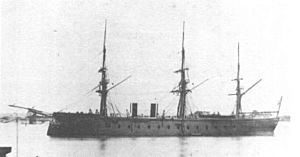Spanish ironclad Sagunto facts for kids
The Spanish ironclad Sagunto was a powerful warship built for the Royal Spanish Navy (called Armada Real in Spanish) between the 1860s and 1870s. She was first planned as a very big wooden ship of the line, but while she was still being built, her design was changed. She became a central-battery ironclad, which meant her main guns were protected in a strong, armored section in the middle of the ship. The Sagunto was removed from the navy's list of ships in 1891.
class="infobox " style="float: right; clear: right; width: 315px; border-spacing: 2px; text-align: left; font-size: 90%;"
| colspan="2" style="text-align: center; font-size: 90%; line-height: 1.5em;" | 
|}
Contents
| History | |
|---|---|
| Name | Sagunto |
| Namesake | Siege of Saguntum |
| Ordered | March 1860 |
| Builder | Reales Astilleros de Esteiro, Ferrol |
| Laid down | 12 January 1861 |
| Launched | 26 April 1869 |
| Completed | 1 February 1877 |
| Commissioned | February 1877 |
| Renamed | Sagunto, 1868 |
| Stricken | 1891 |
| General characteristics | |
| Type | Central-battery ironclad |
| Displacement | 7,352 t (7,236 long tons) |
| Length | 89.5 m (293 ft 8 in) (waterline) |
| Beam | 17.3 m (56 ft 9 in) |
| Draft | 8.4 m (28 ft) |
| Installed power | |
| Propulsion | 1 shaft, 2 compound-expansion steam engines |
| Sail plan | Ship rig |
| Speed | 12.5 knots (23.2 km/h; 14.4 mph) |
| Complement | 554 |
| Armament |
|
| Armor |
|
Ship Design and Features
The Sagunto was a large ship, measuring about 89.5 meters (293 feet 8 inches) long at the waterline. She was 17.3 meters (56 feet 9 inches) wide and had a draft of 8.4 meters (27 feet 7 inches). The ship weighed about 7,352 metric tons (7,236 long tons) when fully loaded. She also had a special ram at her bow, designed to crash into enemy ships. A total of 554 officers and sailors worked on board.
Engine and Speed
The ship was powered by two steam engines imported from a company called Forges et Chantiers de la Méditerranée. These engines used steam from eight large cylindrical boilers. The engines produced 3,700 indicated horsepower (ihp), which allowed the Sagunto to reach a speed of 12.5 knots (23.2 km/h; 14.4 mph). She could carry up to 900 metric tons (886 long tons) of coal to fuel her engines.
Sails and Rigging
Even with steam engines, the Sagunto also had a full set of sails. She was fitted with a three-masted ship rig, meaning she had square sails on all three masts. Her total sail area was 2,400 square meters (25,833 sq ft), which helped save coal and allowed her to travel silently when needed.
Ship's Weapons
The Sagunto was originally planned to have many smoothbore guns along her sides. However, she was completed with a more modern setup. Her main weapons were eight 229-millimeter (9-inch) rifled muzzle-loading (RML) guns. These guns were placed in a central armored section on the main deck.
She also had smaller guns on the upper deck. These included two 180-millimeter (7.1-inch) RML guns, one on each side. There was also another 180-millimeter RML gun at the front of the ship, used for firing straight ahead. By 1883, the smaller guns were replaced with similar ones made by a different company.
Ship's Armor
To protect herself in battle, the Sagunto had a complete belt of wrought iron armor around her waterline. This armor was 150 millimeters (5.9 inches) thick. The central section where her main guns were located also had armor of the same thickness. However, the front and back ends of the ship, and the deck, did not have any armor protection.
Building and Service History
The Sagunto was named after the ancient Siege of Saguntum, a famous battle. She was ordered in December 1862. At first, she was going to be a 100-gun ship of the line named Principe Don Alfonso. She began construction on March 21, 1863, at the Royal Shipyard of Esteiro in Ferrol.
In 1868, while still being built, her name was changed to Sagunto. This was also when her design was changed to become a central-battery ironclad. The ship was officially launched into the water on April 26, 1869. She was finally ready for service and officially commissioned into the Spanish Navy on February 1, 1877.
Images for kids
See also
 In Spanish: Sagunto (1869) para niños
In Spanish: Sagunto (1869) para niños



